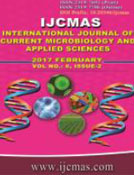


 National Academy of Agricultural Sciences (NAAS)
National Academy of Agricultural Sciences (NAAS)

|
PRINT ISSN : 2319-7692
Online ISSN : 2319-7706 Issues : 12 per year Publisher : Excellent Publishers Email : editorijcmas@gmail.com / submit@ijcmas.com Editor-in-chief: Dr.M.Prakash Index Copernicus ICV 2018: 95.39 NAAS RATING 2020: 5.38 |
The field experiment were conducted during September 2010 to December 2010 at the Regional Research Station, Tamil Nadu Agricultural University, Paiyur to assess the effect of drought stress on growth and productivity of rainfed ragi and to identify suitable management practices through physiological modifications to mitigate the drought effect. The experiment was laid out in factorial randomized block design with three replications. The treatments comprised of four chemicals viz., TNAU Nutrient Mix (1.00 %), TNAU Nutrient Mix (1.50 %), Brassino steroids (0.1 ppm) and Cycocel (50 ppm) along with one untreated control in three ragi varieties- Paiyur 2, L-5 and GPU 28. The foliar spray method was used to spray nutrients and growth hormones at flowering stage for suitable management for stress alleviation. The effect of treatments was assessed by periodical observations on the morphological characters, dry matter partitioning, growth rates during critical stages and ultimately the yield. In this experiment, a significant difference was observed in plant height, number of tillers per plant, number of ear heads per plant and dry matter production per plant. Except Cycocel (50 ppm), all the other treatments showed positive influence in increasing the morphology, growth and development of the plant. Among the treatments, TNAU nutrient mix (1.5%) with a mean yield of 2078 kg/ha and a yield advantage of 22.1 % over control was found to be best treatment in alleviating the drought stress. Application of TNAU nutrient mix (1.0%) and Brassino steroids (0.1 ppm) were also found to be effective as these treatments were on par with the best treatment. The overall performance of Paiyur 2 was the best among the three varieties tested and confirms its suitability for all seasons.
 |
 |
 |
 |
 |